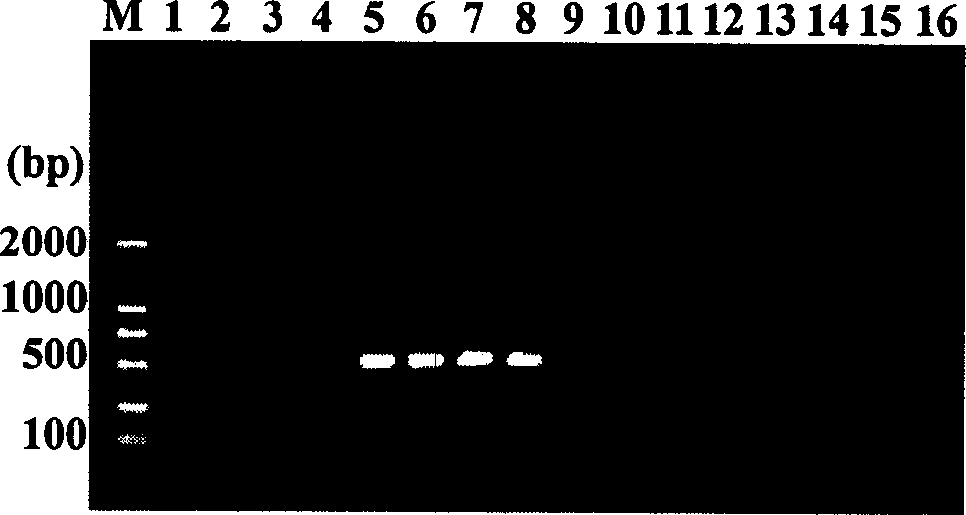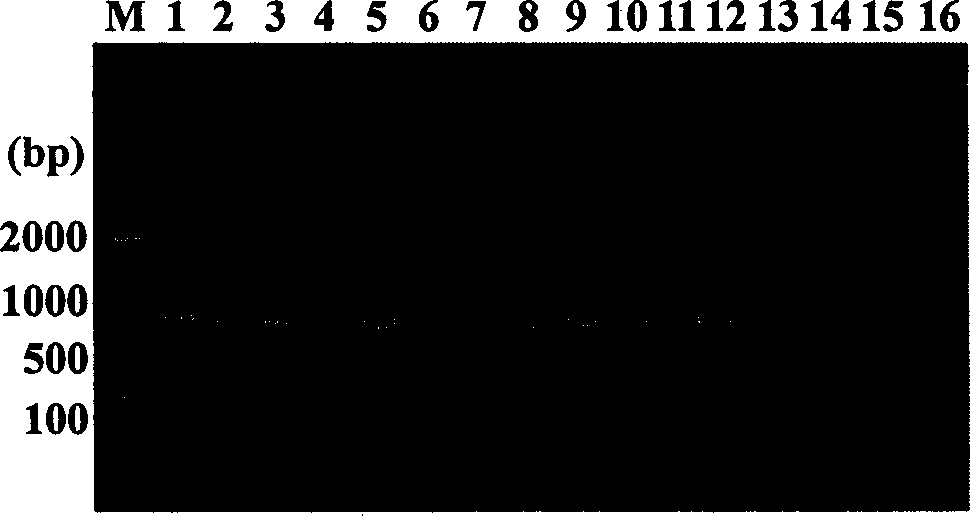Primer and method for rapid molecular detection of eelworm
A root-knot nematode and molecular detection technology, applied in biochemical equipment and methods, microbial determination/inspection, DNA preparation, etc., can solve the problems of unstable and reliable test results, inability to identify larvae, long diagnosis time, etc. Guaranteed reliability, easy and fast operation, and strong practicability
- Summary
- Abstract
- Description
- Claims
- Application Information
AI Technical Summary
Problems solved by technology
Method used
Image
Examples
Embodiment 1
[0040] Southern (M.incognita), Java (M.javanica), peanut (M.arenaria) originating from China, Thailand, Iran, Australia, Netherlands, Belgium, Italy, Poland and the United States using primers MI-F and MI-R , northern (M.hapla) and root-knot nematode (M.enterolobii) 43 groups of genomic DNA carry out PCR amplification, the result only amplifies the product of 955bp on the root-knot nematode population (table 1; figure 1) . PCR reaction system 12.5μl, including 5ng nematode DNA, 0.4μM primers MI-F and MI-R, 0.2mM dNTPs, 1×ExTaq PCR buffer (including 2mM MgCl 2 ) and 1U ExTaq DNA polymerase (Takara Biotech, Dalian, China). The PCR conditions were: pre-denaturation at 94°C for 4min; 35 cycles of 94°C for 30s, 62°C for 30s and 72°C for 30s; and final extension at 72°C for 10min. The PCR instrument used was Eppendorf Mastercycler Personal (Eppendorf, Germany). Embodiment 2: Primer MJ-F / R is to the specific amplification of root-knot nematode javanica
Embodiment 2
[0041] Use primers MJ-F and MJ-R to pair the southern (M.incognita), Java (M.javanica), peanut (M.arenaria) originating from China, Thailand, Iran, Australia, the Netherlands, Belgium, Italy, Poland and the United States , northern (M.hapla) and root-knot nematode (M.enterolobii) 43 populations of genomic DNA carry out PCR amplification, the result only amplifies the product of 517bp on the root-knot nematode Java population (table 1; figure 2) . PCR reaction system 12.5μl, including 5ng nematode DNA, 0.4μM primers MJ-F and MJ-R, 0.2mM dNTPs, 1×ExTaq PCR buffer (including 2mM MgCl 2 ) and 1U ExTaq DNA polymerase (Takara Biotech, Dalian, China). The PCR conditions were: pre-denaturation at 94°C for 4min; 35 cycles of 94°C for 30s, 62°C for 30s and 72°C for 30s; and final extension at 72°C for 10min. The PCR instrument used was Eppendorf Mastercycler Personal (Eppendorf, Germany). Embodiment 3: The specific amplification of primer MI-F / MT-R to Southern, Java and peanut root-...
Embodiment 3
[0042] Southern (M.incognita), Java (M.javanica), peanut (M.arenaria) originating from China, Thailand, Iran, Australia, Netherlands, Belgium, Italy, Poland and the United States using primers MI-F and MT-R , northern (M.hapla) and root-knot nematode (M.enterolobii) 43 populations of genomic DNA were amplified by PCR, and as a result, a 779bp product was amplified on the southern, Java and peanut root-knot nematode populations, No amplified product (table 1; image 3) . PCR reaction system 12.5μl, including 5ng nematode DNA, 0.4μM primers MI-F and MT-R, 0.2mM dNTPs, 1×ExTaq PCR buffer (including 2mM MgCl 2 ) and 1U ExTaq DNA polymerase (Takara Biotech, Dalian, China). The PCR conditions were: pre-denaturation at 94°C for 4min; 35 cycles of 94°C for 30s, 62°C for 30s and 72°C for 30s; and final extension at 72°C for 10min. The PCR instrument used was Eppendorf Mastercycler Personal (Eppendorf, Germany). Example 4: Utilize primers MI-F / R, MJ-F / R and MI-F / MT-R to identify sin...
PUM
 Login to View More
Login to View More Abstract
Description
Claims
Application Information
 Login to View More
Login to View More - R&D
- Intellectual Property
- Life Sciences
- Materials
- Tech Scout
- Unparalleled Data Quality
- Higher Quality Content
- 60% Fewer Hallucinations
Browse by: Latest US Patents, China's latest patents, Technical Efficacy Thesaurus, Application Domain, Technology Topic, Popular Technical Reports.
© 2025 PatSnap. All rights reserved.Legal|Privacy policy|Modern Slavery Act Transparency Statement|Sitemap|About US| Contact US: help@patsnap.com



